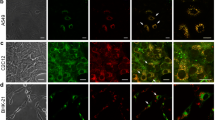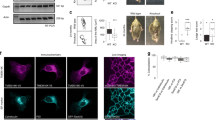Abstract
The lysosome is a membrane-bound organelle involved in the turnover of various intracellular and extracellular macromolecules. These are degraded by acidic hydrolases in the lumen of lysosome. The lysosomal membrane is important not only in retaining the acidic hydrolases to protect cells against cytosolic proteolysis, but it also facilitates protein trafficking though organelle fusion. In this study, we report on a novel lysosomal membrane protein transmembrane 6 superfamily 1 (Tm6sf1). Expression of Tm6sf1-DsRed fusion proteins in HEK293A cells displayed punctate or ringlike vesicles, which colocalized with conventional lysosome markers including LAMP1/2, RAB7, and Rnf167. Using fluorescence time-lapse live cell imaging, we demonstrated the fusion of Tm6sf1 vesicles with lysosomes and the integration of Tm6sf1 into the lysosomal membrane. We also examined the expression of Tm6sf1 in mouse tissues and found immunopositive signals in major organs such as the cerebellum, kidney, and intestine. These data suggest that Tm6sf1 is a widely expressed lysosomal transmembrane protein and can be used as a novel marker of lysosome.





Similar content being viewed by others
References
Boya P (2012) Lysosomal function and dysfunction: mechanism and disease. Antioxid Redox Signal 17:766–774
Callahan JW, Bagshaw RD, Mahuran DJ (2009) The integral membrane of lysosomes: its proteins and their roles in disease. J Proteomics 72:23–33
Carim-Todd L, Escarceller M, Estivill X, Sumoy L (2000) Cloning of the novel gene TM6SF1 reveals conservation of clusters of paralogous genes between human chromosomes 15q24--q26 and 19p13.3--p12. Cytogenet Cell Genet 90:255-260
Gao C, Yu CK, Qu S, San MW, Li KY, Lo SW, Jiang L (2012) The Golgi-localized Arabidopsis endomembrane protein12 contains both endoplasmic reticulum export and Golgi retention signals at its C terminus. Plant Cell 24:2086–2104
Holmen OL, Zhang H, Fan Y, Hovelson DH, Schmidt EM, Zhou W, Guo Y, Zhang J, Langhammer A, Lochen ML, Ganesh SK, Vatten L, Skorpen F, Dalen H, Pennathur S, Chen J, Platou C, Mathiesen EB, Wilsgaard T, Njolstad I, Boehnke M, Chen YE, Abecasis GR, Hveem K, Willer CJ (2014) Systematic evaluation of coding variation identifies a candidate causal variant in TM6SF2 influencing total cholesterol and myocardial infarction risk. Nat Genet 46:345–351
Kozlitina J, Smagris E, Stender S, Nordestgaard BG, Zhou HH, Tybjaerg-Hansen A, Vogt TF, Hobbs HH, Cohen JC (2014) Exome-wide association study identifies a TM6SF2 variant that confers susceptibility to nonalcoholic fatty liver disease. Nat Genet 46:352–356
Lubke T, Lobel P, Sleat DE (2009) Proteomics of the lysosome. Biochim Biophys Acta 1793:625–635
Luzio JP, Pryor PR, Bright NA (2007) Lysosomes: fusion and function. Nat Rev Mol Cell Biol 8:622–632
Mahdessian H, Taxiarchis A, Popov S, Silveira A, Franco-Cereceda A, Hamsten A, Eriksson P, Van’t Hooft F (2014) TM6SF2 is a regulator of liver fat metabolism influencing triglyceride secretion and hepatic lipid droplet content. Proc Natl Acad Sci U S A 111:8913–8918
Potter SS, Hartman HA, Kwan KM, Behringer RR, Patterson LT (2007) Laser capture-microarray analysis of Lim1 mutant kidney development. Genesis 45:432–439
Ricketts CJ, Hill VK, Linehan WM (2014) Tumor-specific hypermethylation of epigenetic biomarkers, including SFRP1, predicts for poorer survival in patients from the TCGA Kidney Renal Clear Cell Carcinoma (KIRC) project. PLoS One 9:e85621
Saftig P, Klumperman J (2009) Lysosome biogenesis and lysosomal membrane proteins: trafficking meets function. Nat Rev Mol Cell Biol 10:623–635
Schroder BA, Wrocklage C, Hasilik A, Saftig P (2010) The proteome of lysosomes. Proteomics 10:4053–4076
Schwake M, Schroder B, Saftig P (2013) Lysosomal membrane proteins and their central role in physiology. Traffic 14:739–748
Skalsky RL, Samols MA, Plaisance KB, Boss IW, Riva A, Lopez MC, Baker HV, Renne R (2007) Kaposi’s sarcoma-associated herpesvirus encodes an ortholog of miR-155. J Virol 81:12836–12845
Tao R, Li J, Xin J, Wu J, Guo J, Zhang L, Jiang L, Zhang W, Yang Z, Li L (2011) Methylation profile of single hepatocytes derived from hepatitis B virus-related hepatocellular carcinoma. PLoS One 6:e19862
Wong VW, Wong GL, Tse CH, Chan HL (2014) Prevalence of the TM6SF2 variant and non-alcoholic fatty liver disease in Chinese. J Hepatol
Yu L, McPhee CK, Zheng L, Mardones GA, Rong Y, Peng J, Mi N, Zhao Y, Liu Z, Wan F, Hailey DW, Oorschot V, Klumperman J, Baehrecke EH, Lenardo MJ (2010) Termination of autophagy and reformation of lysosomes regulated by mTOR. Nature 465:942–946
Acknowledgments
The authors would like to thank Mr. Freddie Kwok for the technical support on live cell imaging. The work described in this paper was supported by grants from the Research Grants Council of the Hong Kong Special Administrative Region, China (Project No. CUHK2/CRF/11G and AoE/M-05/12).
Conflict of interest
The authors declare that they have no conflict of interest.
Author information
Authors and Affiliations
Corresponding author
Additional information
Handling Editor: Reimer Stick
Electronic supplementary material
Below is the link to the electronic supplementary material.
Supplementary Video 1
Fluorescence time-lapse live imaging video showing budding of Tm6sf1 vesicle (red) and fusion with LAMP1+ve lysosome (green) (AVI 177 kb)
Supplementary Video 2
Fluorescence time-lapse live imaging video showing the integration of Tm6sf1 (red) into LAMP1+ve lysosomal membrane (green) (AVI 492 kb)
Supplementary Fig. 1
Tm6sf1 (red) did not colocalize with early endosome (EEA1, green), Cis-Golgi (GM130, green), Trans-Golgi (GalTase, green), mitochondria (COXIV, green), plasma membrane (CD44, green) and cytoskeleton markers (α-tubulin, green). Scale bars: 20 μm (GIF 1.7 mb)
High resolution image
(TIFF 4.81 mb)
Rights and permissions
About this article
Cite this article
Tam, W.Y., Jiang, L. & Kwan, K.M. Transmembrane 6 superfamily 1 (Tm6sf1) is a novel lysosomal transmembrane protein. Protoplasma 252, 977–983 (2015). https://doi.org/10.1007/s00709-014-0733-x
Received:
Accepted:
Published:
Issue Date:
DOI: https://doi.org/10.1007/s00709-014-0733-x




